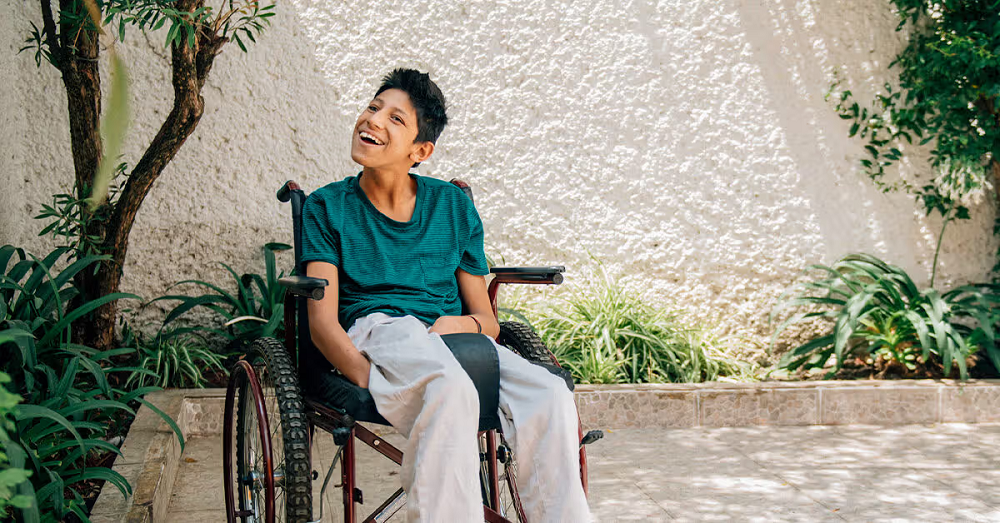
Defining Cerebral Palsy: A Brief Overview
Cerebral Palsy (CP) is a neurological disorder that affects movement, muscle tone, and posture. It is the most common motor disability in childhood, resulting from abnormal brain development or damage to the developing brain that affects a person’s ability to control their muscles.
- Types: CP is categorized into spastic, dyskinetic, ataxic, and mixed types, each with distinct symptoms and motor patterns.
- Symptoms: These can range from mild to severe and may include difficulties with coordination, stiff or weak muscles, tremors, and involuntary movements.
- Diagnosis: Early diagnosis is crucial and involves a combination of medical history, physical exams, and various tests such as MRI or CT scans.
- Prognosis: While CP is a lifelong condition, the prognosis varies widely. Some individuals can live independently, while others may require more comprehensive care.
- Causes: CP can be caused by factors such as birth injuries, infections, and inadequate blood flow to the brain during pregnancy or childbirth.
- Associated Disorders: Many individuals with CP also experience related conditions such as intellectual disabilities, seizures, and vision or hearing impairments.
Treatment for CP is highly individualized and may include physical therapy, occupational therapy, speech therapy, and medication. The goal of these treatments is to improve functional abilities and quality of life. In some cases, surgical interventions may be necessary. Support from a multidisciplinary team is essential in managing the various aspects of CP.
The Psychological Challenges Associated with Physical Disabilities
Living with a physical disability like cerebral palsy can present a myriad of psychological challenges that extend beyond the physical symptoms. The daily reality of managing a disability can lead to feelings of frustration, isolation, and dependency, which can significantly impact one’s mental health.
- Frustration often arises from the limitations imposed by the disability, affecting the ability to perform everyday tasks and engage in activities that were once taken for granted.
- Isolation can occur as individuals may find it difficult to participate in social events or access certain environments, leading to a sense of loneliness and disconnection.
- Dependency on others for care and assistance can affect self-esteem and foster a sense of helplessness.
These emotional responses are natural, yet they require attention and support to prevent the development of more serious mental health issues. It is important to recognize that the psychological impact of cerebral palsy is as significant as the physical challenges. Resources such as websites that provide information on birth injuries and cerebral palsy can be invaluable in offering support and guidance to those affected.
Statistics: Mental Health Concerns Among Individuals with Cerebral Palsy
The prevalence of mental health issues among individuals with cerebral palsy is a significant concern that has been highlighted in various studies. Research indicates that people with cerebral palsy experience higher rates of mental health disorders compared to the general population.
- Depression and Anxiety: These are the most common mental health conditions reported, with anxiety disorders being particularly prevalent among children and adolescents with cerebral palsy.
- Behavioral and Emotional Disorders: There is also a notable incidence of behavioral problems and emotional disorders, which can be attributed to the stress associated with managing a chronic physical condition.
- Social Isolation: The challenges of social integration can lead to feelings of isolation and loneliness, further exacerbating mental health issues.
It is crucial to recognize these statistics not as mere numbers but as a reflection of the lived experiences of individuals with cerebral palsy. Understanding the scope of these mental health concerns is the first step towards developing targeted interventions and support systems.
Navigating Emotional Well-being with Cerebral Palsy
Coping Mechanisms for Emotional Resilience
Individuals with cerebral palsy often face unique emotional challenges, necessitating the development of robust coping mechanisms to foster resilience. Building emotional resilience is a multifaceted process that involves recognizing one’s emotions, understanding the triggers, and developing strategies to manage stress and adversity.
Key coping strategies include:
- Mindfulness and relaxation techniques: Practices such as meditation, deep breathing, and progressive muscle relaxation can help reduce anxiety and improve mood.
- Physical activity: Engaging in regular exercise tailored to individual abilities can boost endorphins and enhance overall well-being.
- Creative expression: Art, music, and writing provide outlets for emotions and can be therapeutic in managing feelings of frustration or isolation.
- Social connections: Maintaining strong relationships with family, friends, and support groups offers emotional support and a sense of community.
It’s essential for individuals with cerebral palsy to have access to resources that can guide them in building these coping mechanisms. A comprehensive website page can be an invaluable tool, providing information on cerebral palsy, treatments, and community support, as well as guidance on navigating legal aspects such as birth injury lawsuits for financial compensation.
The Role of Support Systems in Mental Health
For individuals with cerebral palsy, support systems play a crucial role in maintaining and enhancing mental health. These systems can include family, friends, healthcare professionals, and community networks. Each group provides a unique form of support that collectively contributes to the individual’s psychological well-being.
- Family offers emotional backing and daily assistance, creating a stable environment that can help mitigate stress and anxiety.
- Friends provide social interaction and a sense of belonging, which are vital for emotional health.
- Healthcare professionals are essential for managing both the physical and mental health aspects of cerebral palsy, offering treatments and coping strategies.
- Community networks can offer resources, advocacy, and a platform for shared experiences, fostering a sense of empowerment and reducing feelings of isolation.
It is important to recognize that the quality and availability of these support systems can vary greatly among individuals. Effective support systems are characterized by understanding, acceptance, and active involvement in the individual’s life. They can significantly influence the management of cerebral palsy and the prevention of mental health issues such as depression and anxiety. Therefore, strengthening these support networks is a key aspect of comprehensive care for those living with cerebral palsy.
Therapeutic Interventions and Their Effectiveness
Therapeutic interventions play a crucial role in addressing the mental health needs of individuals with cerebral palsy. These interventions are tailored to meet the unique challenges posed by the physical disability and aim to improve overall psychological well-being.
- Cognitive-behavioral therapy (CBT) is one of the most common approaches. It helps patients develop coping strategies to manage negative thoughts and emotions related to their condition.
- Physical therapy can also have psychological benefits, as it often leads to improved mobility and independence, which can boost self-esteem and reduce feelings of helplessness.
- Occupational therapy focuses on enhancing daily living skills, further contributing to a sense of autonomy and accomplishment.
The effectiveness of these therapies is well-documented, with many patients reporting significant improvements in mood, anxiety levels, and quality of life. However, the success of therapeutic interventions can vary based on individual circumstances and the presence of a supportive environment. It is also important to note that access to these therapies can be limited by factors such as healthcare coverage and availability of specialized care providers. The Merck Manual Consumer Version, a trusted source of medical information since 1899, offers extensive resources on birth injuries and other medical issues that can be invaluable for those seeking to understand the complexities of cerebral palsy and its treatment options.
The Intersection of Cerebral Palsy and Childhood Development
Early Childhood Interventions and Long-term Mental Health Outcomes
The formative years of a child’s life are crucial for development, and this is particularly true for children with cerebral palsy. Early childhood interventions are designed to address the unique challenges faced by these young individuals, aiming to improve not only their physical capabilities but also their mental and emotional well-being.
- Individualized Therapy Plans: Tailored to meet the specific needs of each child, these plans often include physical, occupational, and speech therapies.
- Parent and Family Education: Equipping families with the knowledge and skills to support their child’s development is a key component of early intervention.
- Social Skills Development: Programs that focus on social interaction can help children with cerebral palsy build confidence and reduce feelings of isolation.
Studies have shown that children who receive comprehensive early interventions tend to have better mental health outcomes as they grow older. These interventions can lead to increased self-esteem, improved coping skills, and a greater sense of control over their environment. The positive effects of these early efforts often extend into adolescence and adulthood, highlighting the importance of timely and appropriate support during the early years.
The Impact of Cerebral Palsy on Social Skills and Peer Relationships
Children and adolescents with cerebral palsy often face unique challenges when developing social skills and forming peer relationships. The physical manifestations of the condition can lead to self-consciousness and social anxiety, which may hinder their ability to interact comfortably with others.
- Physical barriers, such as difficulties with speech or motor functions, can make it hard for individuals to participate in common social activities, leading to feelings of isolation.
- Perceived differences by peers can contribute to a lack of understanding and empathy, resulting in social exclusion or bullying.
- Communication challenges often require alternative methods for expression, which can be unfamiliar to those without disabilities, further complicating social interactions.
It is crucial for caregivers and educators to facilitate inclusive environments that promote social integration. This can be achieved through adaptive programs that encourage peer engagement and through education that fosters a deeper understanding of cerebral palsy among non-disabled peers. By addressing these social hurdles, individuals with cerebral palsy can experience improved mental health and a stronger sense of community.
Educational Challenges and Psychological Support
Children with cerebral palsy often face unique educational challenges that can impact their mental health. Navigating a school system designed for the able-bodied requires adaptations and support to ensure that these students can thrive academically and socially.
- Individualized Education Plans (IEPs) are crucial for addressing specific learning needs and providing accommodations.
- Assistive technologies can empower students by enhancing their ability to communicate and participate in class.
- Peer support groups within schools can foster a sense of belonging and reduce feelings of isolation.
However, the psychological impact of these educational challenges should not be underestimated. The frustration of encountering physical barriers, the effort required to keep up with peers, and the potential for social exclusion can take a toll on a child’s mental health. It is essential for educators, parents, and mental health professionals to work collaboratively to provide psychological support alongside educational assistance. This support can take many forms, including counseling, therapy, and the development of social skills through structured activities. By addressing both educational and psychological needs, children with cerebral palsy can be better equipped to face the challenges of their condition and achieve their full potential.
Stigma, Society, and Self-Perception
Combating Stigma and Promoting Inclusivity
Stigma surrounding cerebral palsy and other physical disabilities can lead to social isolation and mental health challenges. To combat this, it is essential to foster an environment of inclusivity and understanding. Education plays a pivotal role in this endeavor, as it can dispel myths and promote empathy among the general public.
Key strategies to promote inclusivity involve:
- Raising awareness through public campaigns that highlight the capabilities and achievements of individuals with cerebral palsy.
- Encouraging media outlets to portray individuals with disabilities in a realistic and positive light.
- Implementing inclusive policies in educational institutions and workplaces to ensure equal opportunities for all.
Inclusivity not only benefits individuals with cerebral palsy by reducing discrimination but also enriches society by embracing diversity. It is a collective effort that requires the participation of governments, organizations, and communities to create lasting change.
How Society’s Perceptions Affect Self-Esteem and Mental Health
The perceptions held by society can profoundly influence the self-esteem and mental health of individuals with cerebral palsy. These societal attitudes often manifest in the form of stereotypes and misconceptions, which can lead to discrimination and social isolation. The impact is multifaceted, affecting not only personal relationships but also opportunities for education and employment.
- Stereotypes and Misconceptions: Persistent stereotypes can lead to individuals with cerebral palsy being underestimated or unfairly judged based on their physical abilities rather than their talents and character.
- Discrimination: Discriminatory practices in various sectors, including the workplace, can limit the opportunities available to those with cerebral palsy, contributing to feelings of inadequacy and frustration.
- Social Isolation: Negative societal perceptions can result in social exclusion, which is detrimental to mental health and can exacerbate feelings of loneliness and depression.
It is crucial to challenge these societal perceptions through education and awareness campaigns. By promoting understanding and acceptance, it is possible to create a more inclusive environment that fosters positive self-esteem and better mental health outcomes for individuals with cerebral palsy.
The Importance of Positive Representation in Media and Culture
Positive representation in media and culture plays a crucial role in shaping public perceptions and attitudes towards individuals with cerebral palsy. When the media portrays these individuals in a diverse and empowering light, it can significantly influence societal views and contribute to a more inclusive environment.
- Highlighting success stories of those with cerebral palsy can inspire and motivate others facing similar challenges.
- Educational programs and campaigns can raise awareness and understanding, reducing stigma and misconceptions.
- Inclusive casting and storytelling in films, TV shows, and books can reflect the true diversity of society and provide role models for people with disabilities.
It is essential for media outlets to collaborate with disability advocates to ensure that the narratives are authentic and respectful. Such partnerships can lead to more accurate depictions and a free claim review for birth injuries, which might be relevant for families seeking compensation for medical negligence. The presence of strong, multidimensional characters with cerebral palsy in mainstream media not only normalizes disability but also empowers individuals by showing them as capable and complex human beings.
Advancements and Resources for Mental Health Support
Innovations in Psychological Care for Individuals with Cerebral Palsy
Recent advancements in psychological care have opened new avenues for individuals with cerebral palsy (CP) to manage their mental health effectively. These innovations are tailored to address the unique challenges faced by those living with CP, ensuring that mental health support is both accessible and specialized.
- Teletherapy: The advent of teletherapy has made psychological services more accessible to people with mobility issues. Through video conferencing, individuals with CP can receive counseling and therapy in the comfort of their own homes.
- Virtual Reality (VR) Therapy: VR technology is being used to create immersive environments that can help individuals with CP overcome anxiety and stress. It also serves as a tool for practicing social skills in a controlled setting.
- Cognitive-Behavioral Therapy (CBT) Adaptations: Therapists are developing adaptations of CBT specifically for those with CP, focusing on coping strategies for dealing with the psychological impact of living with a physical disability.
- Mindfulness and Relaxation Techniques: Mindfulness-based stress reduction and other relaxation techniques are being tailored to the needs of individuals with CP, helping them to manage stress and improve their overall mental well-being.
These innovations not only enhance the quality of mental health care but also empower individuals with CP to take an active role in their psychological well-being. As research continues, it is expected that more targeted and effective treatments will become available, further improving the lives of those affected by cerebral palsy.
Navigating Healthcare Systems: Access to Mental Health Services
For individuals with cerebral palsy, navigating the complexities of healthcare systems to access mental health services can be a daunting task. The journey often begins with understanding the available services and how to utilize them effectively.
- Identifying Providers: The first step is to identify mental health professionals who have experience with physical disabilities, particularly cerebral palsy.
- Insurance Coverage: Understanding insurance coverage and out-of-pocket costs is crucial, as it influences the accessibility of services.
- Coordination of Care: Coordinating care between various health professionals can ensure a comprehensive approach to mental health.
Once the logistical aspects are addressed, the focus shifts to the quality of care. It is important for healthcare providers to offer personalized care plans that take into account the unique challenges faced by those with cerebral palsy. Moreover, advocating for oneself or seeking an advocate to navigate these systems can be instrumental in receiving appropriate care. The ultimate goal is to establish a supportive network that not only addresses mental health concerns but also enhances overall well-being.
Community and Online Resources for Support and Advocacy
In the digital age, community and online resources have become invaluable for individuals with cerebral palsy seeking support and advocacy. These platforms offer a plethora of information, connect people with similar experiences, and provide a space for empowerment and collective action.
- Online Forums and Support Groups: Virtual communities where individuals can share experiences, seek advice, and find emotional support from peers.
- Educational Websites: These sites offer resources about cerebral palsy, including treatment options, coping strategies, and rights for individuals with disabilities.
- Social Media Campaigns: Campaigns that raise awareness, challenge misconceptions, and promote the achievements of those living with cerebral palsy.
- Advocacy Organizations: Groups that work to influence policy, improve accessibility, and fight for the rights of people with disabilities.
It is crucial for individuals with cerebral palsy and their families to be aware of these resources. They not only provide support but also help in building a more inclusive society. By engaging with these platforms, individuals can find a sense of community and the tools necessary to advocate for their needs and rights.




